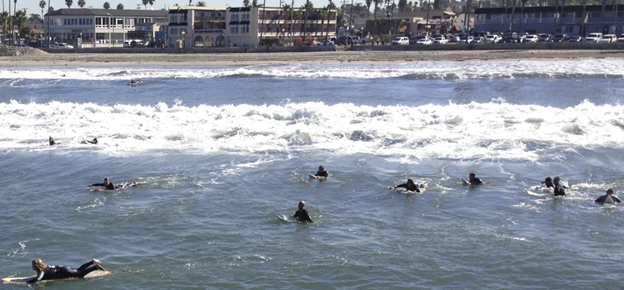For years, Southern California’s stormwater management community has relied on a DNA marker known as HF183 to detect human sources of fecal contamination in runoff.
Although HF183 is widely used today as a tool for detecting human contamination, HF183 is not itself a pathogen, and there are no health thresholds that have been developed that explain illness risks for beachgoers and other humans who may inadvertently ingest pathogens associated with this contamination.
That’s why the SMC is investing in a four-year study to answer the key management question of “How much HF183 is too much?”
The ongoing study, expected to be completed in 2024, is probing the relationship between HF183 levels in wet-weather runoff and the risk of illness from exposure to fecal contamination. By understanding what levels of HF183 correspond to health risks for humans, managers can use HF183 to estimate which areas pose the greatest risks – and prioritize and allocate resources accordingly.

HF183 is a DNA marker that is found in a type of gut bacteria known as Bacteroides spp. It is uniquely associated with human fecal contamination, meaning that when managers detect HF183, they know the fecal source is not from dogs or birds or another animal source that poses a lesser health risk than human fecal sources pose.
HF183 is a relatively new indicator of fecal contamination compared to more established indicators of fecal contamination like Enterococcus and E. coli. Scientists already have established the relationship between Enterococcus and E. coli levels and human health risk, which has enabled robust beach water-quality testing programs to be built around measuring Enterococcus and E. coli. The limitation of these established fecal contamination indicators is that they are not human-specific, meaning that they cannot distinguish between human and nonhuman sources like HF183 can.
During the SMC study, researchers will work to establish the relationship between HF183 levels and human health risk via modeling. Previous studies have modeled the health risks associated with swimming in water contaminated with raw sewage during dry weather, but not the health risks associated with exposure to contaminated stormwater.
The SMC’s member agencies initiated field sampling during the 2021-2022 wet season and are completing sampling during the current 2022-2023 wet season. Then, the SMC will use a health risk modeling approach known as quantitative microbial risk assessment (QMRA) to model illness rates from water contact. QMRA is an approach for setting water-quality standards that is approved by the U.S. Environmental Protection Agency.
Dive deeper
SMC Winter 2023 Newsletter
Volume 3, Issue 2
This newsletter is published three times a year by the Southern California Stormwater Monitoring Coalition (SMC). To subscribe to this newsletter, contact [email protected].
